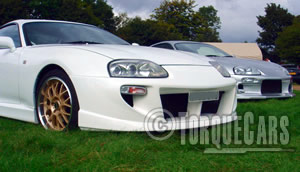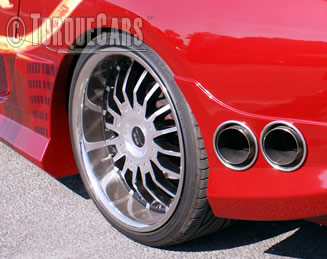Toyota Supra Tuning.
"Thanks for reading my Toyota Supra tuning tips."

The legendary Toyota Supra is one of the most reliable sports cars released and one of the most easily tuned.
Production run was from 1993 and the last of the models rolled off the production line in 1996.
The awesome twin turbo engine produces 327 BHP and pushes the car to 60 miles per hour in just 4.9 seconds.
Originally designed for an easy and reliable 600 bhp by Toyota engineers. Executives however bowed to market forces and cut the power back to almost half its originally intended level. This ensured reliability and better fuel economy but makes it a tuner dream.
It also means that the engine is over machined effectively making it bulletproof. TorqueCars expect to see power gains up to 700bhp before having to get the engine machined and toughened up.

Fuel economy is not the major concern of a Toyota Supra over as the car will typically return around 20 miles to the gallon and use a set of rear tyres every few months!
Traction is probably the biggest problem affecting the Toyota Supra. A softer compound tire will certainly help. And many owners fit wider rims so there is a greater contact area with the ground. See our wheels and tire articles for more information on this.
The beauty of the Toyota Supra is the simplicity required to exact high power gains. The combination of a boost controller and remap will raise the power to 400 to 500 BHP. At these power levels you will benefit from the cold air induction kit and full sports exhaust.
Tuning modifications.
These are the performance parts are usually fitted by our members, decide how far you wish to go in your tuning project before you get started.
Getting the right modified upgrade kits for your planned usage of the car is vital. Stage 3 motor sport parts just won't work well on the road making the car difficult to drive.
Please watch TorqueCars Video tutorial on car tuning. And be sure to subscribe and support our new channel.
Guide to the Best Tuning Mods & Upgrades
- Mods that Remove a Restriction
If the intake or exhaust are restricted in any way this will have an impact on your cars performance, so use an induction kit/filter upgrade and better flowing exhaust whenever your tuning creates a flow restriction.
- Mods that Improve Handling
Braking, Suspension and general alignment of the suspension components is vital for any tuning project even before you start increasing power.
- Fit Stronger Parts
Tuned cars will show up weaknesses, typically in the turbochargers, clutch and internal engine components. Whilst most engines can cope with mild tuning mods, TorqueCars recommend that you upgrade the internal components before these weak spots manifest themselves.
- ECU Tunes & Remapping
While some cars can be easily remapped, others may require piggyback ECU's or aftermarket ECU's but this is the most vital step of your tuning project as it fully releases the power from all of your mods and upgrades. Expect 10-20% on NASP engines and 30-40% on turbocharged units.
- More Power Needs More Fuel & Air
Every tuning project will aim to increase the air supply, but fuel supply is just as vital and will need to match the air the engine can utilise. Fuel to Air ratio is vital so upgrade the fuel pump & injectors. Also you can look to perform head mods (flowing and porting), bigger valves, fast road cams and forced induction upgrades to improve fuel.
Stages of Tune
Stage 1 mods: Lighter flywheel, Alloy wheels, Suspension upgrade (drop 30-40mm), Sports exhaust, Remap, Panel air filter.
Stage 2 mods: Power/Sport clutch, Ported and polished head, Fast road cam, high flow fuel injector, fuel pump upgrades.
Stage 3 mods: Internal engine upgrades (pistons/head/valves), Adding or upgrading forced induction (turbo/supercharger), Competition cam, Engine balancing, Sports gearbox.
Your aim when modding the engine should be a flat and wide torque band. You don't want all the torque to be at the top end of the rev range unless you are creating a motor sport car.
In this article we shall give a brief overview to the best modifications for your car, but we'd encourage you to spend some time on the site looking into the details of each type of performance part.
Fast road cams offer one of the biggest power gains for your money as far as a single sports upgrades goes on a NASP engine.
The exhaust & intake flow play a large part in your cars power band, but be careful here, getting this wrong can upset the idle and make the car impossible to drive in traffic.
You'd need to follow a camshaft upgrade with other mods and finish with a performance chip to fully realise your gains.
You will need to ensure that the engine is not starved of fuel so will need to ramp up the fuelling.
If you find you experience flat spots and surges after your tuning modifications you should check the fuelling and try a higher octane fuel as well. Uprated injectors will enable you to supply sufficient fuel to the engine.
A fuel pump will only deliver a finite amount of fuel, so you may need to uprate this if your injectors are demanding more fuel.

Intake and Exhaust Tuning.
Breathing mods are usually next up.
Please note that WE DO NOT FIND IMPROVEMENTS WITH INDUCTION KITS, unless you have tuned your car massively and are finding that the standard air intake has become a restriction.
There is much debate as to whether a large turbo conversion or work on the existing twin turbo set up will produce the best power gains.
Certainly for drag racing where sheer peak power is important a large turbo seems to be the way to go. The lag of a large turbo can actually help to reign in power for the launch and let the car come on boost as it starts moving.
You also have the option of a large twin turbo set up and boost controller to smooth the power delivery and help compensate for lag. Or why not mix and match have a preliminary small turbo then feed in a larger turbo for the best of both worlds.
Remaps offer impressive power gains on all turbo charged cars. On NASP engines the benefits are doubtful.
However a remap on a NASP engine will help unleash the potential if you have done a lot of mods.
The most impressive power gains for NASP engines usually involve the addition of forced induction.
It is often simpler to add a supercharger than it is to install a turbo. Turbos give boost in exponential proportion to th engine speed and this can make mapping difficult.
It is easier to map a supercharger because the boost is proportional to engine speed on a linear curve. To cope with forced induction you will usually need to decrease the engines compression ratio .
Handling/Suspension upgrades
Many Supra owners uprate the handling of their cars with uprated suspension parts as a priority, this will certainly increase your enjoyment of the car.
If you set the toe out to 1 to 2 degrees on the front, and add a bit of negative camber then cornering will substantially improve.
We would go to a maximum drop of 30mm - 37 mm on most models. You risk compromising your handling if you go lower than this.
Alloy wheel upgrades.
Alloy wheels can help the brakes cool down and are usually lighter than the steel ones. Pay attention to your choice of tyres (tyres) for your car, a good soft compound tyre can really enhance your cars handling. The drawback to large alloy wheels on your Supra is that you're changing your effective final drive ratio so this will have a detrimental effect on performance and acceleration.
Although some people have fitted larger wheels without problems we would stick to an 18 inch rim size as the maximum.
There is a more updated version of this Toyota Supra Tuning article on TorqueCars.com.
For more information on Tuning your car please join us in our friendly forum where you can discuss Supra options in more detail with our Supra owners. It would also be worth reading our unbiased Toyota tuning articles to get a full grasp of the benefits and drawbacks of each modification.
We need your help improving this article, so please send us your feedback in the comments box below and pass on any tips, points or facts we have wrong or have not covered.
We really do love seeing our visitors car projects and which mods work best for them, this site is very much a community effort, and we remind our visitors of our non profit non commercial approach to running this site.
All of your comments are used to improve the accuracy of these articles which are continually revised, tweaked and updated.
Please Check out my YouTube channel, we're regularly adding new content...
PLEASE HELP: I NEED YOUR DONATIONS TO COVER THE COSTS OF RUNNING THIS SITE AND KEEP IT RUNNING. I do not charge you to access this website and it saves most TorqueCars readers $100's each year - but we are NON PROFIT and not even covering our costs. To keep us running PLEASE Donate here
If you liked this page please share it with your friends, drop a link to it in your favourite forum or use the bookmarking options to save it to your social media profile.
Feedback - What do You Think?
Please use our forums if you wish to ask a tuning question, and please note we do not sell parts or services, we are just an online magazine.
Help us improve, leave a suggestion or tip
Please watch this video and subscribe to my YouTube channel.

 Click to accept YouTube Cookies & Play.
Click to accept YouTube Cookies & Play.